Key takeaways:
- A storyboard serves as a visual outline for videos, aiding in emotional expression and narrative clarity.
- Effective storyboarding tools include software like Storyboarder and Canva, as well as traditional methods like pen and paper.
- Key steps to develop a storyboard include defining project objectives, brainstorming scenes, and arranging visuals logically to enhance emotional impact.
- Integrating music effectively can elevate storytelling by aligning visuals with auditory elements, enhancing overall audience experience.
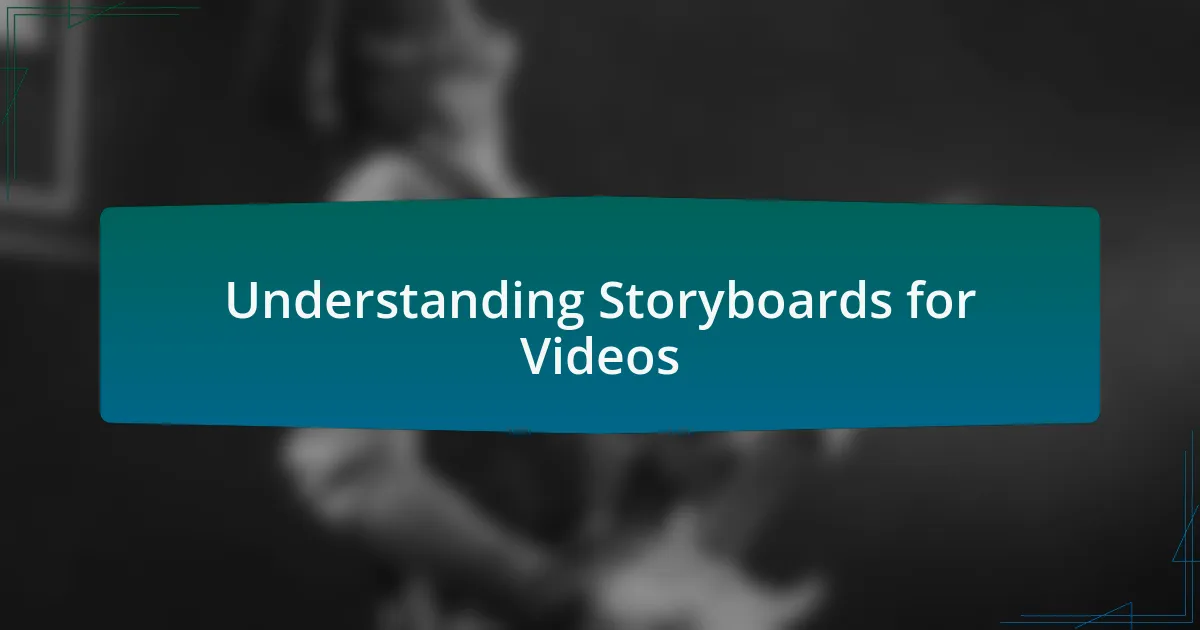
Understanding Storyboards for Videos
A storyboard is essentially a visual plan that outlines each shot in a video. I remember the first time I created a storyboard for a music video project; I felt overwhelmed but excited. The clarity it provided transformed my initial chaos into a structured sequence, making it much easier to visualize the final product.
When I dive into storyboarding, I think about how each frame conveys emotion and narrative. Have you ever watched a video where the visuals evoke powerful feelings? That’s often due to a well-crafted storyboard guiding each artistic choice. This process allows me to consider how colors, angles, and transitions can amplify the music’s mood.
Furthermore, I often find myself revisiting my storyboards after filming. They serve as a reference point, making it easier to assess if the final footage aligns with my original vision. It’s fascinating how this seemingly simple tool can bridge the gap between my creative ideas and their execution. Isn’t it rewarding to see your imagination come to life on screen?
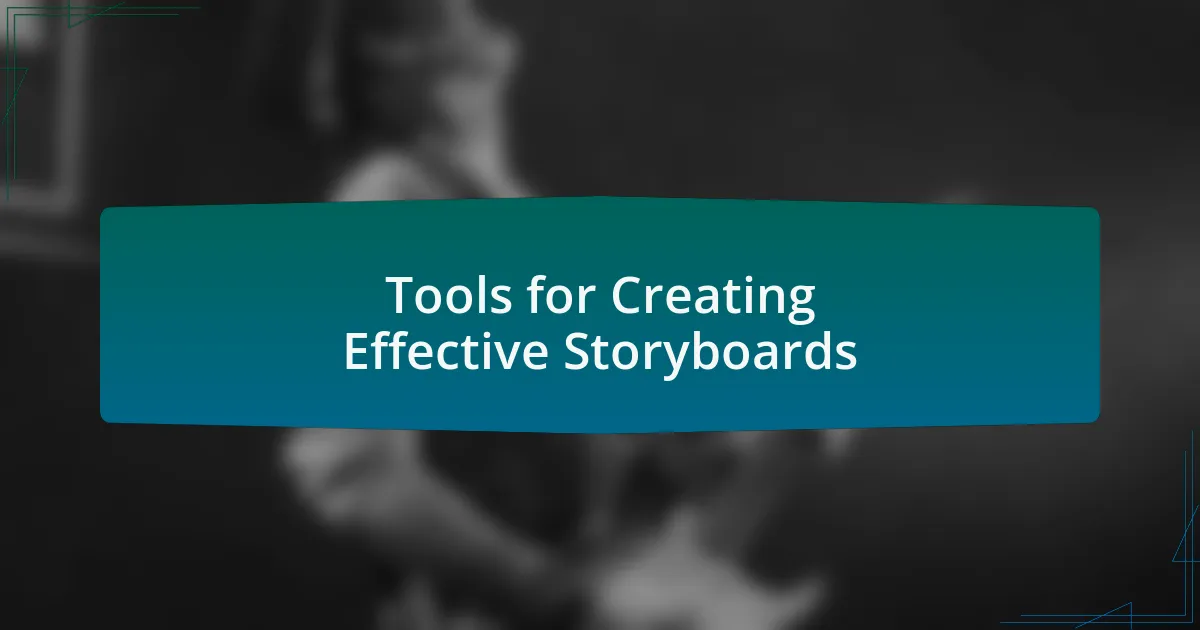
Tools for Creating Effective Storyboards
When it comes to creating effective storyboards, the tools I choose play a pivotal role. I’ve experimented with various software options, and each one brings something unique to the table. For instance, I love using Storyboarder, which offers a simple interface that lets me sketch ideas quickly. It’s as if I’m doodling my thoughts; the user-friendly design not only increases my productivity but also ignites my creativity.
Another favorite of mine is Canva, particularly for those moments when I need to combine images, graphics, and text seamlessly. It allows me to add visual flair to my storyboard without the need for extensive design skills. Have you ever struggled with making your vision come alive visually? Using templates on Canva has remarkably simplified that process for me. I can experiment with different layouts and find the perfect way to communicate my narrative.
But let’s not forget the power of the old-school method: pen and paper. There’s something therapeutic about jotting down my ideas physically. I recall a late-night brainstorming session where I sketched out a storyboard on a notepad while listening to my favorite tracks. The tactile experience of writing helped me connect with the music on a deeper level, something digital tools sometimes fail to achieve. Do you think traditional methods hold a special charm in our tech-driven world? I certainly believe they do, and they often bring a refreshing perspective to my storytelling process.
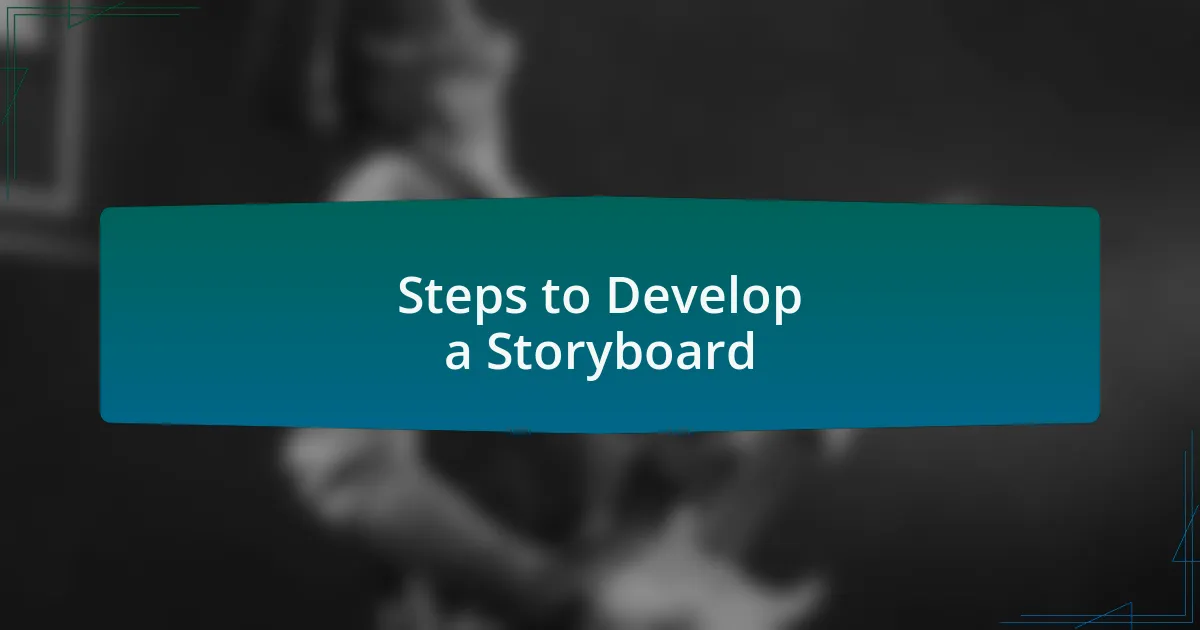
Steps to Develop a Storyboard
To develop a storyboard, the first step involves defining your project’s purpose and objectives. I usually begin by asking myself what story I want to tell and who my audience is. This clarity helps to set the tone and direction for the visualization, shaping the visuals in a way that resonates with viewers. Have you ever noticed how a clear theme can elevate a visual story? I certainly have.
Next, I brainstorm the key scenes or elements that need to be included. Taking a cue from my favorite songs, I think about the essence of each moment—what feeling I want to capture and how each scene contributes to the overall narrative. It’s like mapping out a musical journey, where every note matters. In a recent project, I created a storyboard for a music video by jotting down pivotal points while letting the melody inspire my visuals. This connection between sound and image is thrilling.
Once I have my scenes laid out, I focus on arranging them logically. This includes sketching out the visuals and deciding on transitions between scenes. I often refer back to the emotional impact I want to achieve; a sudden cut can evoke surprise, while a slow fade might draw out a poignant moment. Have you explored how pacing changes the story’s feel? I find that the rhythm of the visuals can be just as crucial as the music itself, giving weight and meaning to the entire project.
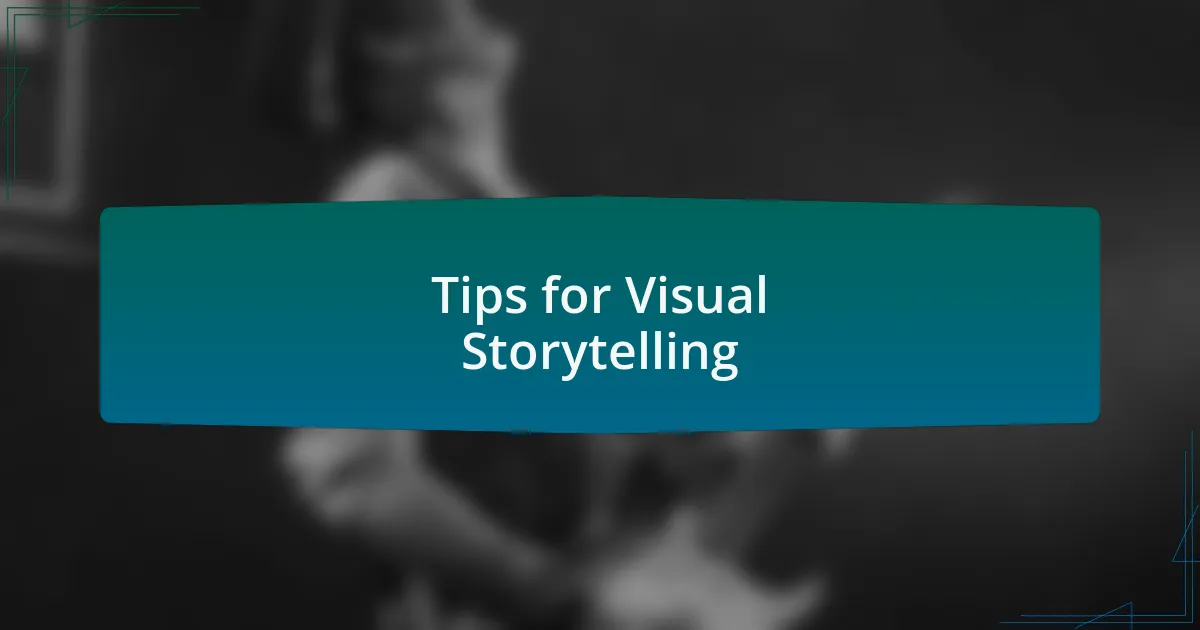
Tips for Visual Storytelling
When it comes to visual storytelling, using color and lighting effectively can dramatically impact how your audience feels. For a project I worked on, I experimented with warm tones to create a sense of nostalgia, which resonated with the song’s theme of lost love. Can you recall a moment in a video where the colors set the mood perfectly? It’s these subtle choices that often linger in the viewer’s memory long after they’ve watched.
Another key aspect is the importance of character development. I always ask myself what makes a character relatable or memorable. In a recent storyboard, I focused on the protagonist’s journey through struggle and triumph, aligning their experiences with the song’s lyrics. This connection not only helps in grounding the visual narrative but also draws the viewer in emotionally. Have you noticed how some characters stick with you because of their depth?
Finally, incorporating movement within your frames can energize your storyboard. Whether it’s a gentle sway to the music or a dramatic shift in perspective, movement can mirror the flow of a song and enhance the overall experience. I often find that the dynamic qualities of visuals reflect the beat and tempo—it’s similar to choreography in dance. How do you think movement influences the impact of a story? I believe that engaging the viewer’s senses keeps the narrative alive and compelling.
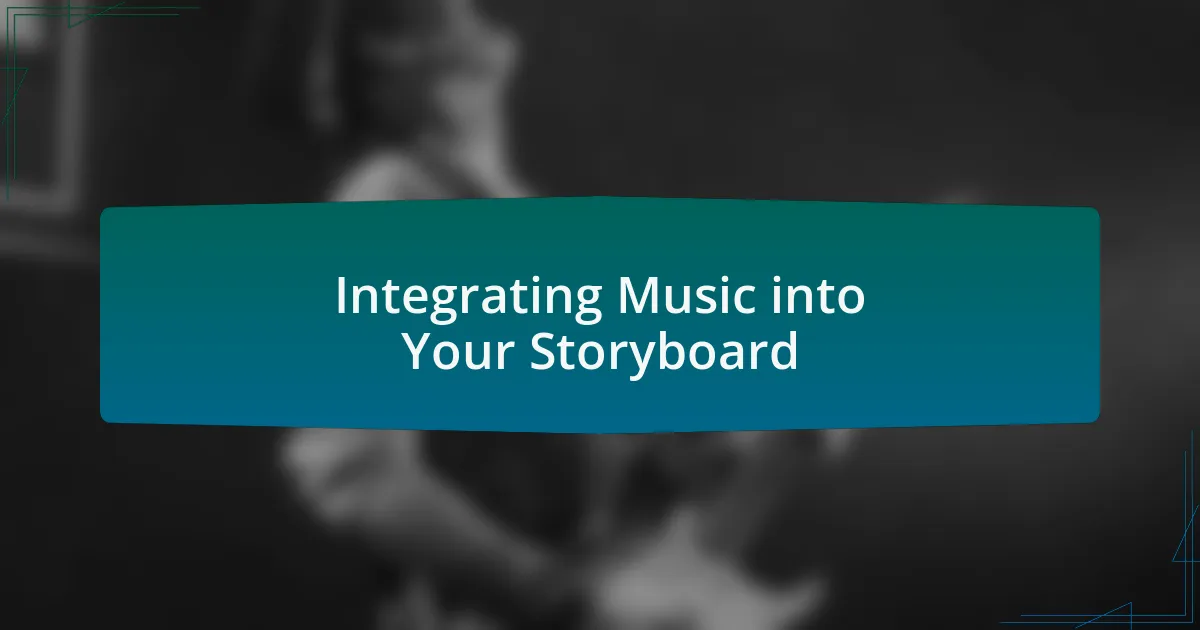
Integrating Music into Your Storyboard
Integrating music into your storyboard is about creating a harmonious relationship between sound and visuals. When I was working on a music video, I spent hours selecting the perfect track, noting how its rhythm influenced my storyboard decisions. I remember choosing a fast-paced song for a dynamic montage, and it was captivating to see how the energy of the visuals aligned with the beat, making everything feel more alive. What music do you think would complement your visuals?
The mood of a piece is often set by the music you choose. I once storyboarded a scene for an emotional ballad, and I deliberately opted for softer, more melancholic visuals to match the song’s poignant lyrics. I find that this synergy can elevate a narrative, leaving your audience feeling everything more deeply. How often do you consider the emotional tone of the music when planning your visuals?
In my experience, utilizing sound cues can enhance storytelling significantly. For instance, adding a crescendo just as a pivotal moment unfolds can amplify the drama and keep viewers on the edge of their seats. During a project, I crafted a montage where each transition was timed with a musical flourish, and the result was eerily fulfilling—it was as if the visuals were dancing with the sound. Have you thought about how sound can guide the viewer’s emotions in your videos?
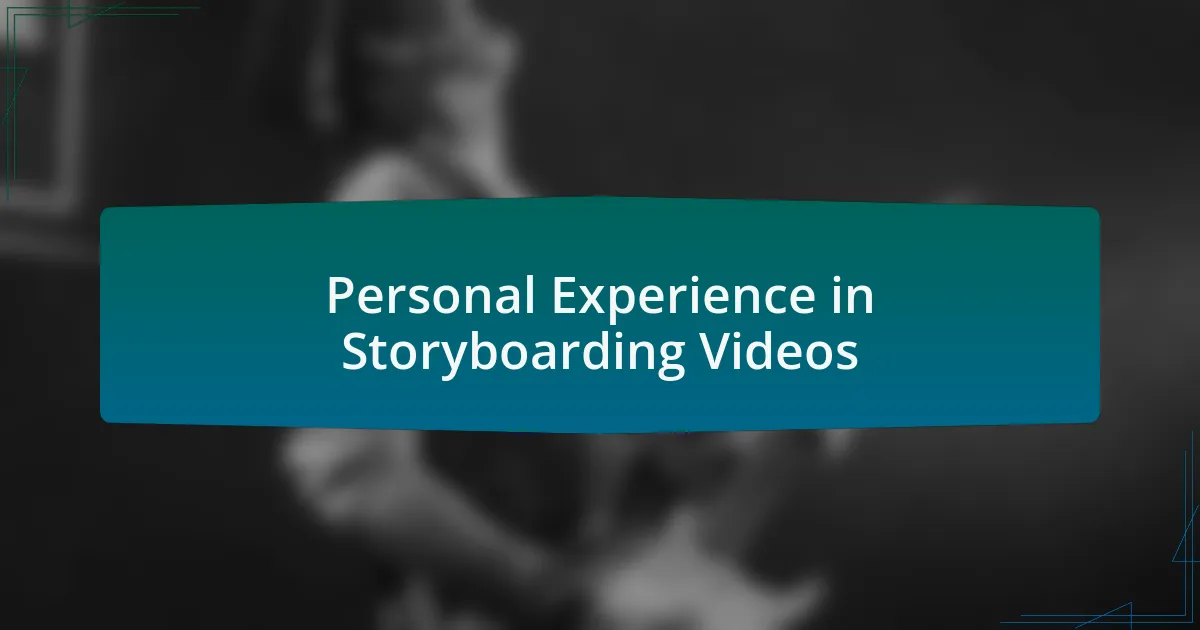
Personal Experience in Storyboarding Videos
When I first started storyboarding videos, I quickly learned that it’s more than just planning shots. I remember diving into my early projects, sketching out scenes on paper, and feeling a wave of excitement as the visuals began to tell a story long before filming started. Have you ever felt that thrill during the creative process?
One project that stands out took me through an emotional rollercoaster. I was tasked with telling the story of a musician’s journey through struggle and triumph. As I envisioned each scene, I felt compelled to incorporate personal touches from my own life, like the late nights spent perfecting a craft, which made the story feel authentic and relatable. How do you infuse your personal experiences into your own visual narratives?
Another memorable instance was during a collaborative project where I worked closely with a director. We debated every scene, considering how colors, angles, and pacing could enhance the music’s rhythm. It was fascinating to see how our discussions transformed into a cohesive storyboard, reflecting not just the music but the emotions behind it. Have you collaborated with others to deepen your storytelling perspective?